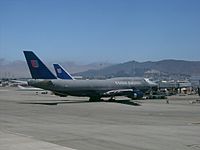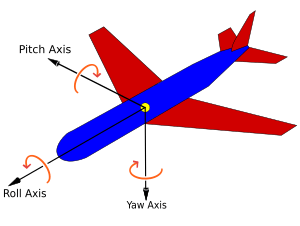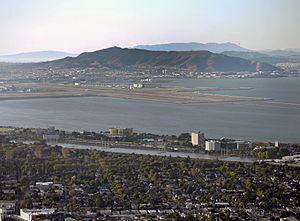United Airlines Flight 863 facts for kids

Boeing 747-400s of United Airlines at San Francisco International Airport; San Bruno Mountain rises to a peak of 1,319 feet (402 m) in the background, excluding radio towers.
|
|
| Occurrence summary | |
|---|---|
| Date | June 28, 1998 |
| Summary | Near-CFIT |
| Place | San Bruno Mountain, after takeoff from San Francisco International Airport |
| Passengers | 288 |
| Crew | 19 |
| Injuries (non-fatal) | 0 |
| Fatalities | 0 |
| Survivors | 307 |
| Aircraft type | Boeing 747-422 |
| Airline/user | United Airlines |
| Registration | Unknown |
| Flew from | San Francisco International Airport, San Mateo County, California |
| Flying to | Sydney Airport, Sydney, New South Wales, Australia |
On June 28, 1998, a large airplane called United Airlines Flight 863 almost crashed. This Boeing 747-400 was flying from San Francisco International Airport to Sydney Airport in Australia. Soon after taking off, one of its engines had a problem. The plane nearly hit San Bruno Mountain while the pilots were trying to fix the issue.
Luckily, the pilots managed to get the plane under control. They flew out over the Pacific Ocean to drop fuel. This made the plane lighter so it could land safely back in San Francisco. This event led United Airlines to make important changes to how its pilots are trained.
Contents
What Happened During the Flight?
Flight 863 took off from San Francisco International Airport at 10:39 pm on Sunday, June 28, 1998. As the huge Boeing 747-400 lifted off the runway, it flew into thick fog.
Engine Trouble Starts
Just after the plane's landing gear went up, the crew heard a "loud thumping noise." The plane also started to shake. The co-pilot was flying the plane at this moment. He first thought a tire might have burst.
At the same time, the temperature of the #3 engine, which is on the right wing, shot up too high. The captain quickly pulled back the power on that engine. This stopped the temperature from rising and the shaking.
Close Call with San Bruno Mountain
There were two other pilots in the cockpit who were not flying. They noticed the plane was losing speed very quickly. They shouted "airspeed!" to warn the co-pilot about a possible stall. A stall happens when a plane loses too much speed to stay in the air.
At this point, a warning system called the "stick shaker" turned on. This system vibrates the control stick to tell pilots the plane is about to stall. The captain immediately took over control of the plane. He tried to keep the plane level to gain speed. But because one engine was not working, the plane started to drift to the right. It came very close to hitting San Bruno Mountain. This mountain is about 1,319 feet (402 m) tall.
The flight recorders showed that the co-pilot had tried to turn the plane left using the wrong controls. He used the "ailerons," which make the plane roll from side to side. To correct for an engine problem, pilots should use the "rudder," which helps steer the plane left or right. Using the ailerons also made parts of the wing pop up, which slowed the plane down even more.
The stick shaker warning came on again. The other pilots told the flight crew to point the plane down slightly to gain speed. But this brought the plane even closer to San Bruno Mountain. Then, the ground proximity warning system shouted a warning to "pull up!" The captain quickly pulled the plane up to avoid crashing into the mountain.
The plane barely missed San Bruno Mountain, clearing it by only about 100 feet (30 m). Air traffic controllers even lost the plane on their radar for about 15 seconds. People living in nearby towns called the airport, worried the plane was about to crash.
After this scary moment, Flight 863 was guided out over the ocean. It dumped its fuel to become lighter. Then, it returned to San Francisco for a safe, but heavy, landing. The co-pilot later said the plane felt slow and hard to climb right after takeoff. He had only flown a 747 once before in the past year.
What Changed After the Incident?
After this close call, United Airlines made big changes to its pilot training. These new rules eventually became standard for many airlines.
All 9,500 of United's pilots watched a video of what happened, made using a flight simulator. Pilots are now required to practice at least three takeoffs and landings every 90 days. At least one of these must be in a real airplane. An aviation expert, Barry Schiff, said this event showed how important basic flying skills are for pilots.
United Airlines still uses Flight 863 for its trips from San Francisco to Sydney. However, they now use newer planes like the Boeing 777-300ER or Boeing 787-9 Dreamliner.
See also
 In Spanish: Vuelo 863 de United Airlines para niños
In Spanish: Vuelo 863 de United Airlines para niños



